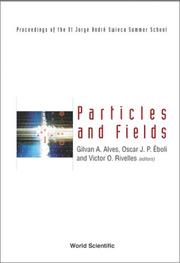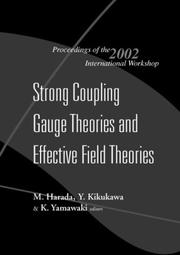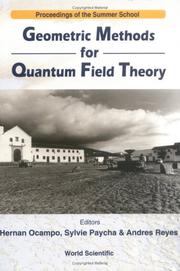| Listing 1 - 10 of 1513 | << page >> |
Sort by
|
Book
ISBN: 3031404335 3031404327 Year: 2023 Publisher: Cham, Switzerland : Springer,
Abstract | Keywords | Export | Availability | Bookmark
 Loading...
Loading...Choose an application
- Reference Manager
- EndNote
- RefWorks (Direct export to RefWorks)
Book
Year: 2002 Publisher: Cambridge, United Kingdom : Cambridge University Press,
Abstract | Keywords | Export | Availability | Bookmark
 Loading...
Loading...Choose an application
- Reference Manager
- EndNote
- RefWorks (Direct export to RefWorks)
This 2002 book discusses the classical foundations of field theory, using the language of variational methods and covariance. It is an ideal supplementary text for courses on elementary field theory, group theory and dynamical systems, and a valuable reference for researchers. It has been reissued as an Open Access publication on Cambridge Core.
Book
ISBN: 1608051951 9781608051953 Year: 2011 Publisher: [Place of publication not identified] Bentham Science Publishers
Abstract | Keywords | Export | Availability | Bookmark
 Loading...
Loading...Choose an application
- Reference Manager
- EndNote
- RefWorks (Direct export to RefWorks)
Classical field theory is employed by physicists to describe a wide variety of physical phenomena. These include electromagnetism, fluid dynamics, gravitation and quantum mechanics. The central entity of field theory is the field which is usually a multi component function of space and time. Those multi component functions are usually grouped together as vector fields as in the case in electromagnetic theory and fluid dynamics, in other cases they are grouped as tensors as in theories of gravitation and yet in other cases they are grouped as complex functions as in the case of quantum mechanic
Book
Abstract | Keywords | Export | Availability | Bookmark
 Loading...
Loading...Choose an application
- Reference Manager
- EndNote
- RefWorks (Direct export to RefWorks)
There are three volumes in this body of work. In Volume 1, we lay the foundation for a general theory of organizing. We propose that organizing is a continuous process of ongoing mutual or reciprocal influence between objects (e.g., human actors) in a field, whereby a field is infinite and connects all the objects in it much like electromagnetic fields influence atomic and molecular charged objects or gravity fields influence inanimate objects with mass such as planets and stars. We use field theory to build what we call the Network Field Model. In this model, human actors are modeled as point-like objects in the field. The influence between and investments in these point-like human objects are explained as energy exchanges (potential and kinetic), which can be described in terms of three different types of capital: financial (assets), human (the individual), and social (two or more humans in a network). This model is predicated on a field theoretical understanding of the world we live in. We use historical and contemporaneous examples of human activity and describe them in terms of the model. In Volume 2, we demonstrate how to apply the model. In Volume 3, we use experimental data to prove the reliability of the model. These three volumes will persistently challenge the reader's understanding of time, position and what it means to be part of an infinite field.

ISBN: 1281929611 9786611929619 9812777318 9789812777317 9812380213 9789812380210 Year: 2002 Publisher: Singapore River Edge, N.J. World Scientific
Abstract | Keywords | Export | Availability | Bookmark
 Loading...
Loading...Choose an application
- Reference Manager
- EndNote
- RefWorks (Direct export to RefWorks)
The Jorge Andre Swieca Summer School is a traditional school in Latin America. This volume contains lectures from its 11th Summer School on Particles and Fields, addressing topics such as collider physics, neutrino phenomenology, noncommutative field theory, string theory and branes.

ISBN: 1281935557 9786611935559 981279512X 9789812795120 9781281935557 9789812384379 9812384375 9812384375 Year: 2003 Publisher: River Edge, N.J. World Scientific
Abstract | Keywords | Export | Availability | Bookmark
 Loading...
Loading...Choose an application
- Reference Manager
- EndNote
- RefWorks (Direct export to RefWorks)
This volume presents the important recent progress in both theoretical and phenomenological issues of strong coupling gauge theories, with/without supersymmetry and extra dimensions, etc. Emphasis is placed on dynamical symmetry breaking with large anomalous dimensions governed by the dynamics near the nontrivial fixed point. Also presented are recent developments of the corresponding effective field theories, such as those including light spectra other than the Nambu-Goldstone particles. This book is a must for all those who are interested in dynamical symmetry breaking and effective field
Book
ISBN: 9812833552 9789812833556 9789812833549 9812833544 Year: 2008 Publisher: Singapore Hackensack, NJ World Scientific
Abstract | Keywords | Export | Availability | Bookmark
 Loading...
Loading...Choose an application
- Reference Manager
- EndNote
- RefWorks (Direct export to RefWorks)
This book contains a collection of essays written in honor of Wolfhart Zimmermann's 80th birthday, most of them based on talks presented at a symposium in his honor.The book shows the unifying force of a subject (Quantum Field Theory) and a person (Zimmermann). It ranges from fundamental questions in quantum physics over applications to particle physics and noncommutative geometry to the latest developments in many body theory and dynamical systems. These key ideas are elucidated by worldwide-recognized experts including Faddeev, Becchi, Buchholz, Lowenstein and Salmhofer.Readers seeking examp
Book
Year: 2022 Publisher: London : IntechOpen,
Abstract | Keywords | Export | Availability | Bookmark
 Loading...
Loading...Choose an application
- Reference Manager
- EndNote
- RefWorks (Direct export to RefWorks)
This book explains the concepts and basic mathematics of quantum computing and communication. Chapters cover such topics as quantum algorithms, photonic implementations of discrete-time quantum walks, how to build a quantum computer, and quantum key distribution and teleportation, among others.
Book
ISBN: 1282442864 9786612442865 9812838961 9789812838964 9812838953 9789812838957 Year: 2009 Publisher: Singapore Hackensack, N.J. World Scientific
Abstract | Keywords | Export | Availability | Bookmark
 Loading...
Loading...Choose an application
- Reference Manager
- EndNote
- RefWorks (Direct export to RefWorks)
Contemporary quantum field theory is mainly developed as quantization of classical fields. Therefore, classical field theory and its BRST extension is the necessary step towards quantum field theory. This book aims to provide a complete mathematical foundation of Lagrangian classical field theory and its BRST extension for the purpose of quantization. Based on the standard geometric formulation of theory of nonlinear differential operators, Lagrangian field theory is treated in a very general setting. Reducible degenerate Lagrangian theories of even and odd fields on an arbitrary smooth manifo
Field theory (Physics) --- Lagrange equations. --- Mathematics.

ISBN: 1281956252 9786611956257 9812810579 9789812810571 9781281956255 9789810243517 9810243510 6611956255 Year: 2001 Publisher: Singapore River Edge, N.J. World Scientific
Abstract | Keywords | Export | Availability | Bookmark
 Loading...
Loading...Choose an application
- Reference Manager
- EndNote
- RefWorks (Direct export to RefWorks)
Both mathematics and mathematical physics have many active areas of research where the interplay between geometry and quantum field theory has proved extremely fruitful. Duality, gauge field theory, geometric quantization, Seiberg-Witten theory, spectral properties and families of Dirac operators, and the geometry of loop groups offer some striking recent examples of modern topics which stand on the borderline between geometry and analysis on the one hand and quantum field theory on the other, where the physicist's and the mathematician's perspective complement each other, leading to new mathe
| Listing 1 - 10 of 1513 | << page >> |
Sort by
|

 Search
Search Feedback
Feedback About UniCat
About UniCat  Help
Help News
News